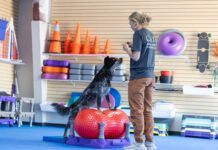Quick: Who was your favorite teacher? Chances are it was somebody charismatic and warm, who had a confidence that made you want to play along.
You know who it was not? The stern lecturer who always seemed a little annoyed at the students, or the muttering substitute who was thrown off by the class clown.
A great teaching vibe goes a long way toward switching on the light in any student. Want your dog to learn fast? Focus on the attitude you’re projecting. What can you do with your voice and your body language to create a great learning environment?
If you’ve ever watched a trainer get an amazing response out of your dog three minutes after they’ve met – when you feel like you do the exact same thing with zero results – this is likely a big part of what’s happening. The trainer has a wonderful teaching vibe, and you can learn that too.
INVITING TONE OF VOICE
At my first-ever dog-training class, I watched the instructor bellow “COME!” to my puppy in a “do-it-or-else” voice. My usually exuberant pup held back, then crept toward him very slowly. I was just 12 years old, but even I knew that felt wrong.
Fifty years later, I sound like a happy cartoon character as I call dogs in a high, cheery tone. It is a sound that promises good things – not a sound filled with threats regarding non-compliance.
Even though dog training has come a long way, people often instinctively boom “Come!” “Leave it!” “Down!” in a big, stern, intimidating voice. That may seem effective in the moment, but in the long run the sensitive-to-tone canine starts to link his owner and training with the feeling of “uh oh.” That makes him less eager to engage and less likely to offer the behaviors you’re hoping to see. Training tends to dwindle off, because nobody’s having fun.
It’s so easy to do it differently! Just keep that voice light. We’re going for the voice of a teacher, not a drill sergeant. It should be strong and clear – no mumbling, no lack of commitment – but keep it inviting.
CLEAR BODY LANGUAGE
When your dog is trying to figure out what you’re asking for, his first stop is going to be your body language. That’s the most fundamental way dogs communicate with each other. Getting your body working for you – rather than against you – will turbocharge your training success.
When people are new to training, their body language usually telegraphs uncertainty. They slouch, they look around, they fumble. Not sure what you look like? Prop your phone up to record a few minutes of your training session. If you’re like the rest of us – even people who train for a living! – you’ll want to improve on what you see.
Here’s how: First, take a deep breath and think through what you’re about to ask of your dog. Have a plan:
- What’s the verbal cue?
- What’s the hand signal?
- When will you mark and reward? If you and pup aren’t successful on the first try, how can you decrease the distance, duration, or distractions to create a win?
The 20 seconds it takes to ponder that will show up in how you hold yourself and give direction, making learning so much easier for your dog.
Other than conveying general confidence, you want your body to be in sync with the specific request you’re making.
If you’re teaching a beginning recall (“Come!”), but you’re standing stock still, you’re sending a mixed message. To a dog, that tall, immobile posture is the opposite of inviting. Think about this: What do dogs do when they want another dog to run toward them? They get low, wiggle some, wag around, and maybe start the running themselves. Mimic that, and watch your dog happily figure out exactly what “come” means.
Conversely, are you having trouble getting your dog to learn “stay”? Check your own body. If you’re slouchy or moving it’s confusing. You can often hold a dog in a stay just by keeping your body utterly still, leaning forward a bit, with eye contact.
When attempting to encourage their dogs to move forward on leash, I see people standing up straight and pulling the leash. That’s working against you! Use your body, not leash pressure, to get your pup going. Bend your knees, get your face closer to the pup, and do some quick dancing steps to engage him.
Whatever you’re trying to teach your dog, remember that it’s largely your body that’s going to communicate it. What can you do with the way you’re holding yourself and moving that will make it clearer to your dog what you’re looking for?
STRESS-FREE ATTITUDE
Now that you’ve got your voice and your body working for you, it’s time to get your emotions on board. Do a quick gut check before you pick up a leash: Are you in a good place? If not, can you take a minute and re-adjust after that bad day at work, or that unsettling conversation with your mother-in-law? If you’re still feeling off, don’t train with your dog. All of that stress is going to go straight into your session, and it will set you back.
Even if you’re feeling fine at the start, frustration can soon set in if you don’t guard against it. Maybe two days ago you’d worked up to a one-minute, 10-foot stay, and today your dog is acting like she’s never heard that word. The worst thing you can do is to get cranky and insist on making that stay happen again.
Instead, take a deep breath and laugh it off, then back up to something that’s an easy win – maybe that’s a string of touches, spins, and sits. If you’re ready to tackle stay again, then start at the easiest level possible: Step back two feet and immediately return. She did it! Ta-da! Now build slowly from there.
For you and your dog to grow as a happy, in-sync team, the key is to delight in small victories. If you do that, training will keep feeling light and fun for you both. And if that happens, you’ll likely opt to train again tomorrow and the next day. You know what that means? That reliable long “stay” really is right around the corner.






